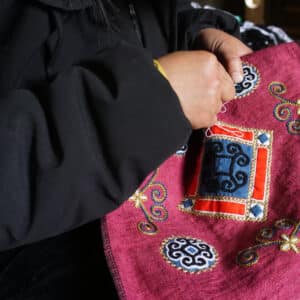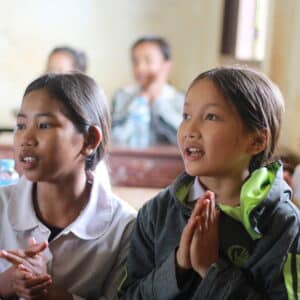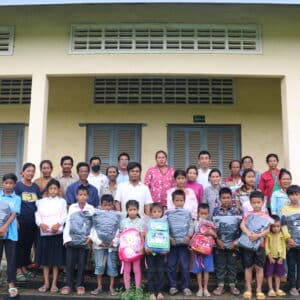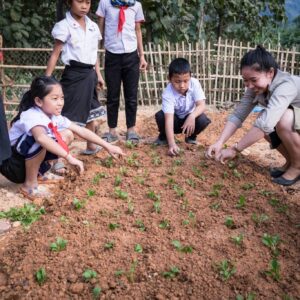In Cambodia, the COVID-19 pandemic has increased the domestic labour responsibilities of children and as prolonged school closures continue, the risk of children being subject child-labour is likely to rise.
In Cambodia’s northwestern city of Poipet, 17-year-old Seiha* was looking forward to returning to school when her school reopened after six months of closures in October 2020.
Her family’s rising levels of poverty due to a loss of livelihoods during the COVID-19 pandemic had meant online learning had been next to impossible to access during school closures and she was sorely missing her classroom environment.
Despite schools’ reopening late last year, due to prevention measures, Seiha’s school bus never resumed its route and she had no way to get to school as her family couldn’t afford the $2.50 per day it would cost for private transport.

“Every day, my friends and I pray that the authorities will allow the bus to run because we miss going to school so much”, said Seiha, when speaking to Aide et Action late last year. “I miss my school, my classes, and my teachers.”
Increasingly poor families
Sadly, Seiha’s story is not unique. In a survey conducted by Save The Children in Cambodia in 2020, more than two thirds of households (67%) surveyed reported losing their income, of which almost half (44%) reported losing more than half of their income.
When schools closed again in March 2021 (and remain closed at the time of writing), pressure was mounting for Seiha to start earning an income full-time. Recently, she left the city to go work on a cashew farm and support her family and is unsure when or if she will return to her school in the city.
Seiha is among the 3.2 million students across Cambodia who experienced 96 days of school closures in 2020 which, according to UNDP, has led to a 4 percent decline in human development, the equivalent of erasing all progress made in human development over the past four years – undoing hard gains won in reducing poverty and improving access to education.
Assessing the risks
To understand the needs of Cambodian students during the pandemic, the Ministry of Education, Youth and Sport and the Education Sector Working Group undertook a comprehensive assessment of the sector. The assessment found that both girls and boys are at an increased risk during school closures as a notable proportion of both groups (17% and 23% respectively) self-reported facing additional violence, abuse or exploitation.
Over half of the respondents (61%) of the assessment reported that children were required to contribute more to household chores since the pandemic and a small number reported children were working full time (6%) or part time (4%) since school closures. Students who have already dropped out of school or who reported as being at high risk of dropping out were found to have either started working or to have increased their contribution to household chores compared to students who reported either a low or no risk of dropping out.
While Seiha is almost considered an adult now, her level of education (Grade 6) is low for age and dropping out of school now will likely limit her opportunities to find gainful employment in the future as well as opportunities to break the cycle of poverty her family have found themselves in.
Loss of learning
With extra domestic chores now on their plates, Cambodian children are not accessing the distance learning measures put in place during the school closures, and running the risk of learning loss – forgetting what they learned in the classroom – a risk that teachers are also expressing concerns about.
Chom Srey Touch, a sewing teacher at local NGO Damnok Toek’s education centre in Poipet, has seen her classroom closed for approximately 11 months since the crisis began in March 2020. As school closures continue, she fears that her teenage students may not return.

“I think the closures are greatly impacting students – the lack of practice and instruction are causing them to forget what they have learnt”, she explains. “If the closures continue I’m afraid that they will find jobs to do and never return back to school”.
Prioritising continuity of education
Aide et Action, leading The Consortium For Out Of School Children, in partnership with Educate A Child (EAC), a global programme of the Education Above All Foundation, is committed to ensuring the continuity of education during school closures.
Since March 2020, Damnok Toek has seen 61 students (18%) drop out of education. Of these, half left the city with their parents in search of work in the countryside as their families could no longer afford to pay their rent. The other half found work during school closures and could no longer find the time to study.
For students like Seiha who have dropped out or are at risk of dropping out, we will work with local partners like Damnok Toek to understand students’ needs and support non-formal education options where formal schooling isn’t realistic.
At the onset of the pandemic, Cambodia ranked 28th in the world in the 2020 Child Labour Index and the highest risk among Southeast Asian countries, for the use of underage workers.
If the global trends are an indicator of how things are going, it’s likely these numbers are only going to get worse as the pandemic endures. According to a new report by the International Labour Organization (ILO) and UNICEF, the number of children in child labour has risen to 160 million worldwide – an increase of 8.4 million children in the last four years – with millions more at risk due to the impacts of COVID-19.
There was also a significant rise in the number of children aged 5 to 11 years in child labour, who now account for over half of the total global figure. The number of children aged 5 to 17 years in hazardous work – defined as work that is likely to harm their health, safety or morals – has risen by 6.5 million to 79 million since 2016.
As we mark World Day Against Child Labour on 12 June 2021, we urge our colleagues, our partners, and our countries’ decision-makers to continue to assess children’s needs during the pandemic and collaborate to provide effective solutions that leave no child behind.
*Names of children under 18 have been changed












